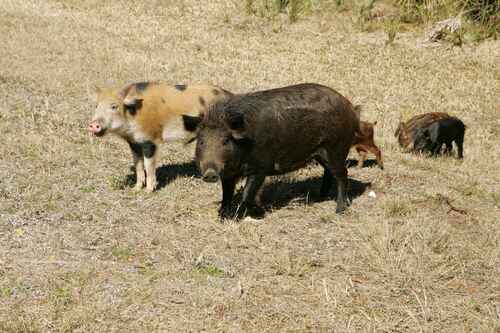Identification | Biology | Damage ID | Management | Handling
Identification
Wild pigs (Sus scrofa) include both feral hogs (domestic swine that have escaped captivity) and wild boars Wild boars are native to Eurasia but were introduced to North America to interbreed with feral hogs. Wild boars and feral hogs hybridize freely, therefore, the term wild pig is appropriate as a generic term for these animals.
Because pigs are highly adaptable and capable of fending for themselves, they were a popular livestock species for early explorers and settlers. In the centuries following European exploration and colonization of the eastern United States, settlers, farmers, and some Native Americans continued to promote the spread of pigs by using free-range livestock management practices. In the early 1900s, Eurasian or Russian wild boars were introduced into portions of the US for hunting purposes. As a result of cross-breeding with wild domestic stock, many hybrid populations now exist throughout the wild pig’s range.
Legal Status
Wild pigs are considered game mammals in several southern states and California. Some states with small populations allow only agency personnel to kill feral hogs. In some states, they are considered an invasive species and have no legal protection.
Physical Description
The size and conformation of wild pigs depend on the breed, degree of hybridization with wild boars, and level of nutrition during the growing period. Males tend to be larger than females. Average total length of adults is 50 to 75 inches, and average weight is 75 to 250 pounds. Pigs larger than the average tend to be the result of feeding by humans. Wild boars have longer legs and larger heads with longer snouts than feral hogs. As with domestic hogs, hybrids may be any color. The color of young boars generally is red-brown with black longitudinal “watermelon” stripes. As juveniles develop, the stripes disappear and color changes from red to brown to black. Male feral hogs and wild boars have continuously growing tusks.
Species Range
Christopher Columbus first introduced pigs to the West Indies in 1493. The first documented introduction to the US was in Florida, by deSoto, in 1593. More introductions followed in Georgia and the Carolinas, which established free-ranging populations in the Southeast. Free-ranging practices continued until they became illegal in the mid-twentieth century. Populations of unclaimed hogs increased and spread throughout the Southeast. Domestic hogs were released in California in 1769, resulting in a free-ranging population of wild pigs.
Today, wild pigs are both numerous and widespread throughout much of the US, with established populations in at least 36 states and an additional 12 states reporting a presence of wild pigs. Historically, problems with wild pigs were limited mostly to the southeastern states, California, Hawaii, and Texas. However, in the last 20 years, wild pig ranges have expanded dramatically to include much of the US, and populations now exist in such northerly climates as Michigan, North Dakota, and the provinces of Manitoba and Saskatchewan in Canada. This current distribution of wild pigs, almost nationwide in scope, is not a consequence of natural events. Instead, it has resulted largely from translocation of wild pigs by humans.

The popularity of wild pigs as a game species has played a major role in the expansion of their range throughout the US. In some cases, the sudden presence of wild pigs in an area where they previously did not exist can be attributed to escapes of stocked animals from privately owned, “game-proof” fenced hunting preserves. In other cases, the sudden presence of wild pigs is a result of illegal translocation: the practice of capturing wild pigs, transporting them to new locations, and releasing them into the wild.
One group that continues to fuel this practice consists of irresponsible and uninformed pig- hunting enthusiasts whose goal is to establish local wild pig populations for recreational hunting. A second group comprises those whose goal is to profit from the capture and sale of wild pigs to hunting enthusiasts. Wild pigs are quick to learn, and those that have been previously captured, transported to a new location, and released often are a daunting challenge to recapture. As a result, these actions contribute to the spread of this nonnative, highly invasive species.
Voice and Sounds
Wild pigs vocalize with grunts and squeals.
Tracks and Signs
Tracks of adult hogs resemble those made by a cow calf. Dewclaws will show on adult hog tracks where the ground is soft. Tracks can be difficult to differentiate from those of deer.

Image by Prevention and Control of Wildlife Damage (PCWD).
